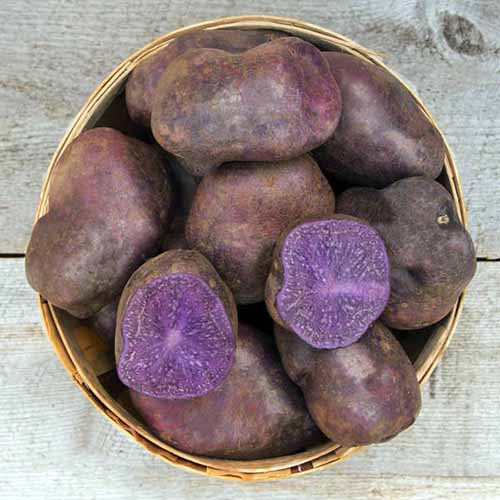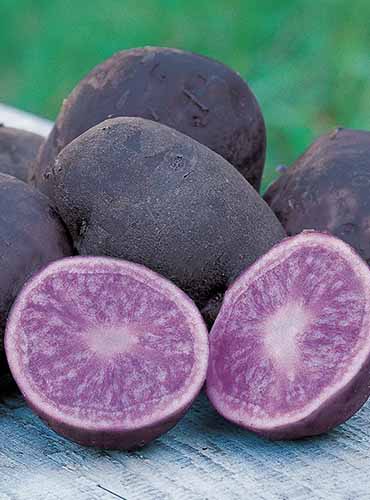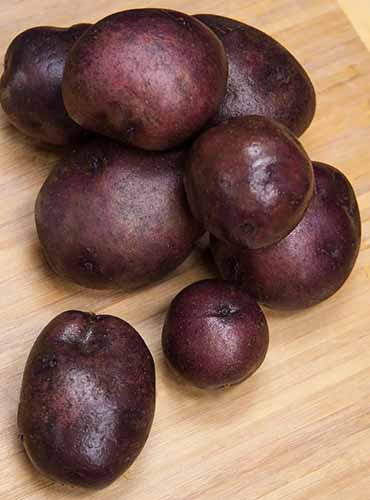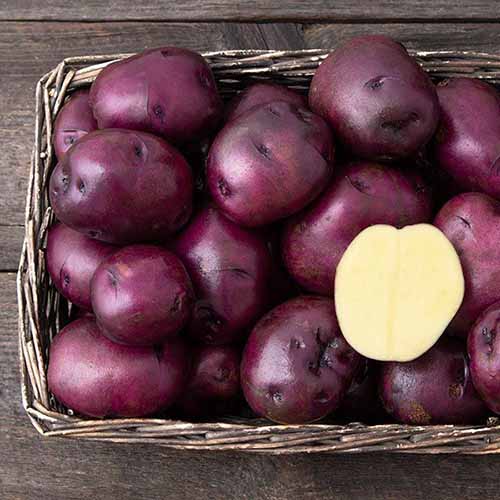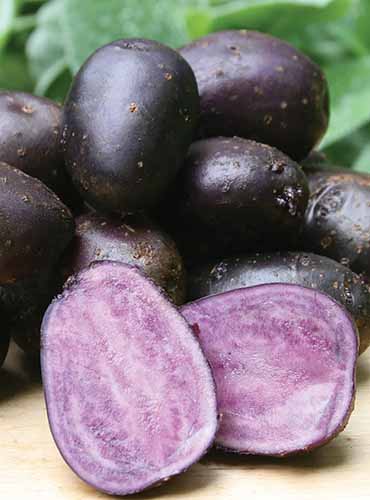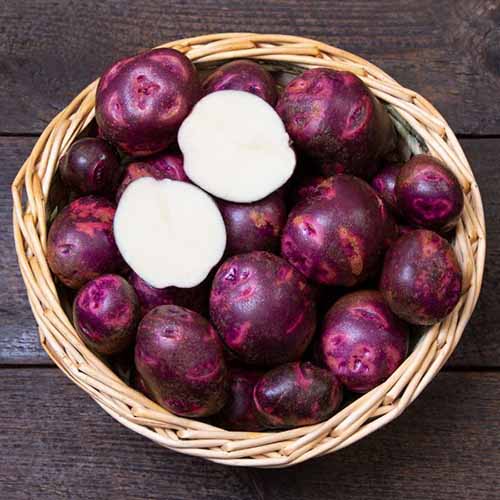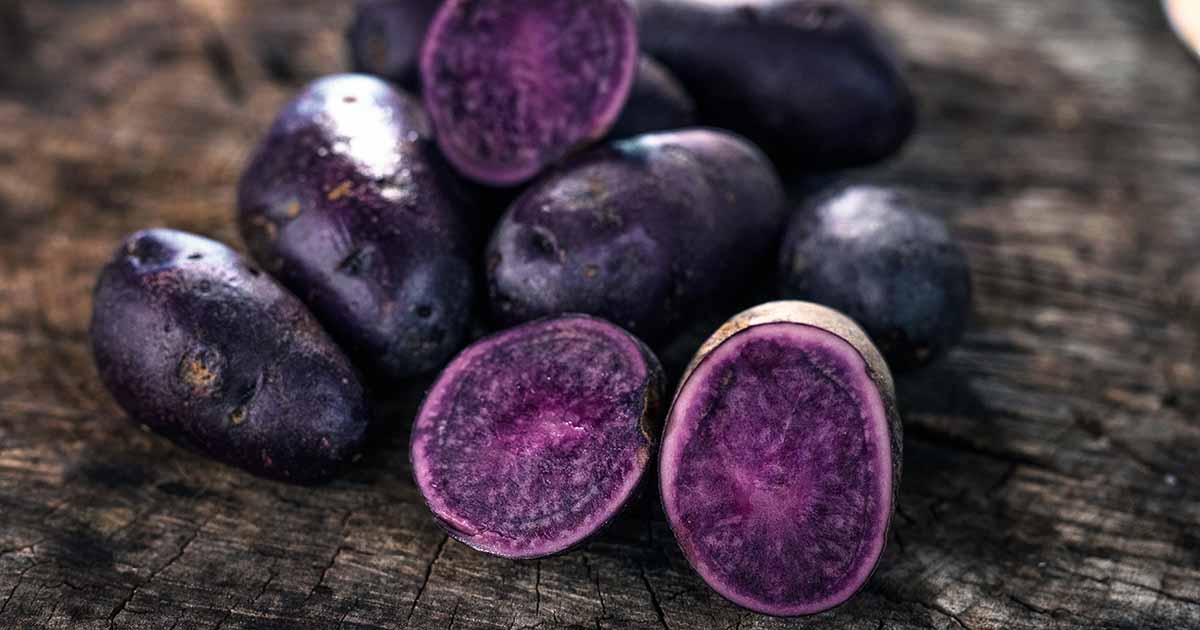
Mashed, smashed, roasted, or fried, I love potatoes.
I’d eat them even if they were the most unattractive color imaginable, but potatoes in jewel-like hues such as purple and blue are downright irresistible. I whip them out anytime I want to wow my guests.
I made a pile of smashed salt and vinegar potatoes using some ‘Huckleberry Gold’ recently, and my friends couldn’t stop raving about how beautiful they were. Apart from tasting insanely good, the dish was also a feast for the eyes.
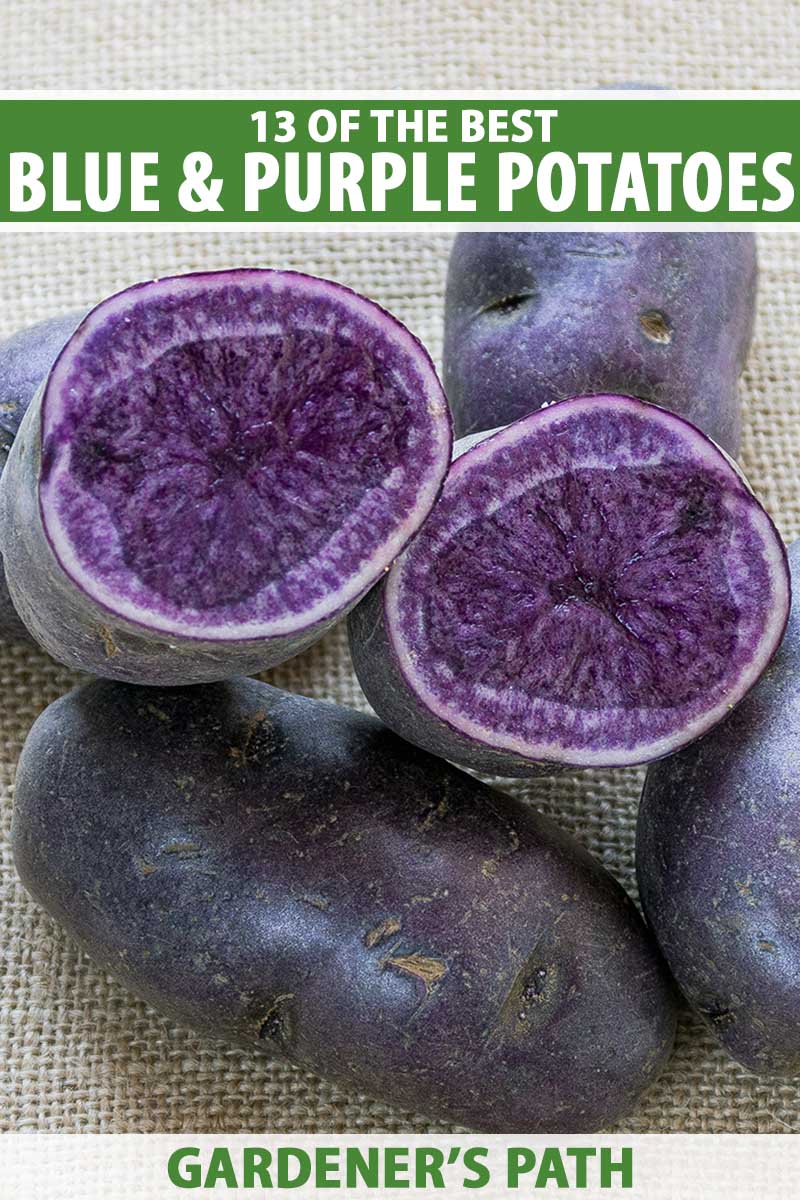
We link to vendors to help you find relevant products. If you buy from one of our links, we may earn a commission.
Blue and purple potatoes don’t just look good, these colorful tubers are also healthier than the standard spud.
We’ll talk about why that is and introduce you to 13 of the prettiest, tastiest options available for you to grow at home. Here’s the lineup:
Best Blue and Purple Potatoes
Purple and blue potatoes contain flavonoid pigments called anthocyanins, which provide the unusual colors as well as a range of health benefits for our gut bacteria, cardiovascular system, and blood sugar management.

Plants develop this hue as a way to absorb light and protect the plant from UV light, and they are the same pigments you find in blueberries and purple cabbage.
Some colorful varieties only have the purple or blue coloration in their skins. Others have the coloring all the way through the flesh as well.
A lot of these vibrant potatoes won’t show their true colors until you scrub the heck out of the skin to remove the dulling dirt.
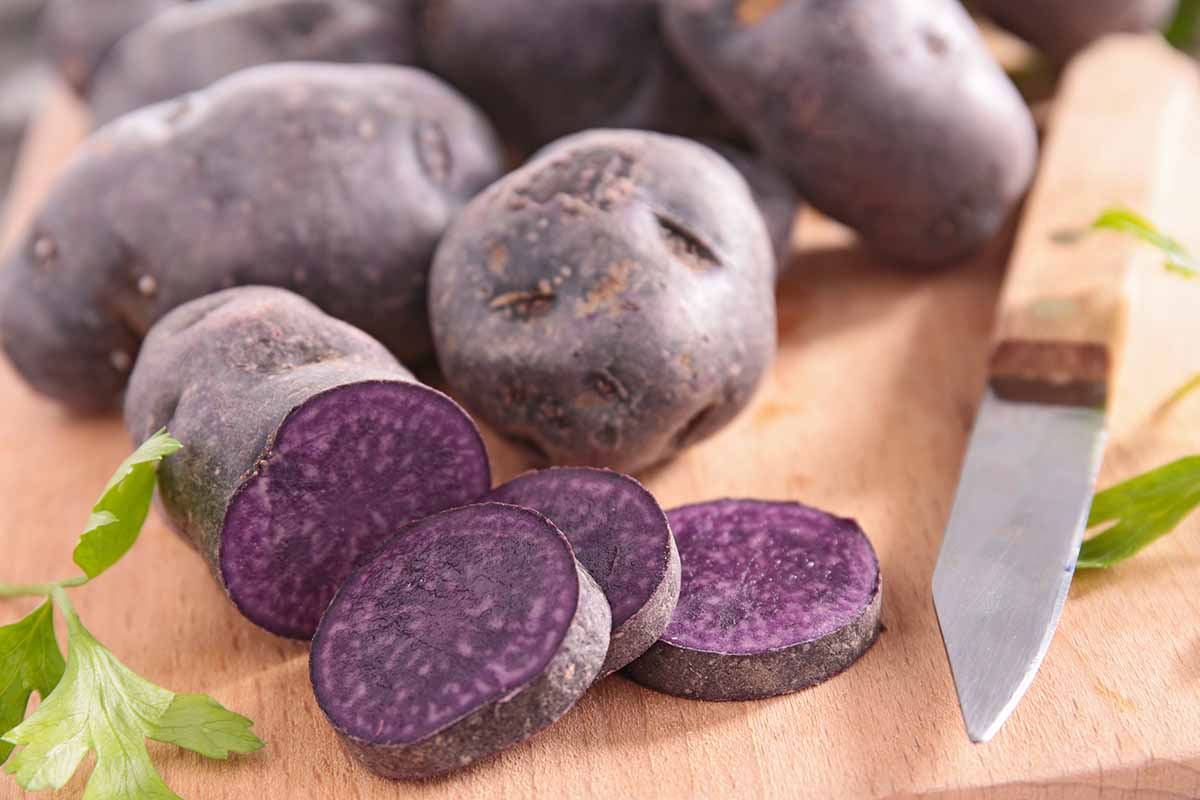
Japanese and Hawaiian sweet potato cultivars are often purple, so don’t confuse Solanum tuberosum with Ipomoea batatas when you’re shopping. They may look somewhat similar but they’re totally different species.
If you’re new to growing potatoes, we have a guide that will walk you through the entire process.
Before we dive in, be sure to familiarize yourself with the time to maturity of the potatoes you want to grow.
In general, those described as early mature in 80 days or less, mid-season varieties take 80 to 95 days, and late types require over 95 days to reach maturity.
Then, let’s start by looking at one of the most popular cultivars:
1. Adirondack Blue
If you come across a blue potato at the store, it’s highly likely you’re looking at ‘Adirondack Blue.’
Bred at Cornell University by Ken Paddock, Robert Plaisted, and Walter de Jong in the Department of Plant Breeding, it was released in 2003 and has been a favorite ever since.
The skin is deep blue with a hint of violet surrounding equally vibrant flesh. Even after cooking, the skin maintains that striking color. It’s an adaptable tuber, ideal for roasting, baking, mashing, and more.
The skin on this oval, mid-season type might have “netting” if it’s exposed to cold temperatures or if it contracts potato leaf roll virus infection.
Netting is a type of defect on the skin of the potato that looks kind of like a net has been wrapped around the tuber. It doesn’t hurt the tuber, but some people don’t like the look.
High Mowing Organics Seeds carries this exceptional blue option in two-and-a-half, 20- and 40-pound quantities.
2. All Blue
With deep blue skin encasing equally blue flesh and a white ring between the skin and flesh, ‘All Blue’ is perfectly named, though you’ll also see it called ‘Blue Marker,’ ‘Fenton Blue,’ or ‘River John Blue.’
When you’re an heirloom potato that has been around for over a century, you tend to pick up a lot of monikers.
This cultivar is extremely drought-tolerant and is sensitive to wet roots, so be careful not to overwater. Otherwise, it’s fairly resistant to problems like scab and late blight.
I think the vibrant hue and oval shape accented with deep eyes makes for a beautiful display in a basket on the shelf.
They are just as attractive cooked and set on the plate, though the flesh will become paler after cooking. Use them for mashing, making fries, roasting, and more.
You can bring home ten tubers from Burpee for a mid- to late season meal.
3. Blackberry
True to their name, ‘Blackberry’ potatoes are so dark that they almost look black, with the same deep, reddish-violet coloring of blackberries.
The thin, dark violet skin is ideal if you prefer not to peel your spuds. The round tubers have deep eyes and the flesh is dark purple all the way through, with a creamy texture perfect for making chips.
‘Blackberry’ is a mid-season type, resistant to blight and wireworm, and produces uniform-sized tubers.
It was developed by Michigan State University’s Potato Breeding and Genetics Program, led by Dave Douches, and Great Lakes Potato Chip Co. Each plant will give you an abundant harvest if you provide ample irrigation, since they are sensitive to drought.
4. Blue Congo
Wine-colored skin encases burgundy colored flesh speckled with white.
The light, airy flesh is perfect for mashing, and you’ll have heaps of cloud-like purple puffs that will wow all your diners.
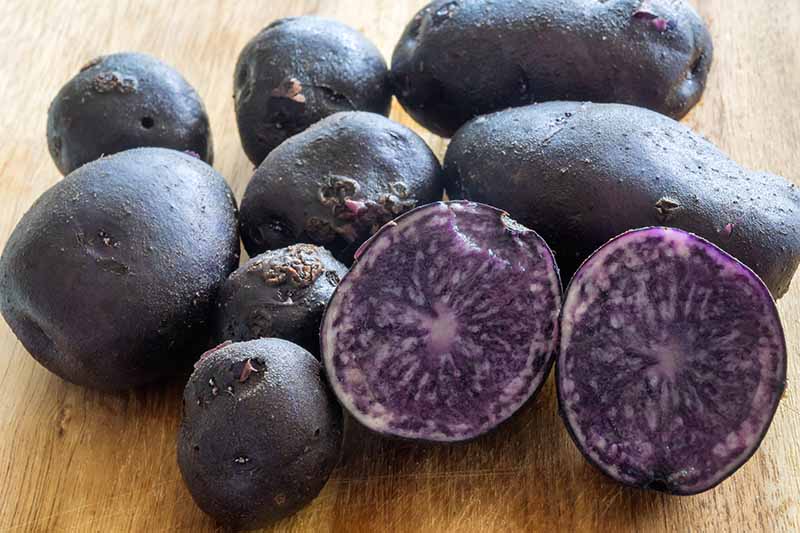
If you like twice-baked potatoes, you’ll love this variety. The thick skin lends itself perfectly to roasting. And if you’re dreaming of violet potato chips, you won’t be disappointed.
The flesh has a nutty, bold flavor and the late-season, long-storing tubers will be a treat for months to come.
5. Blue Sapphire
While sapphire jewels are pretty on a ring or necklace, ‘Blue Sapphire’ is simply delightful on a plate.
The dark blue-purple skin hugs purple flesh with a white marginal ring and white marbling. The thick skin has a waxy texture, giving it a pretty sheen once you wash off the soil.
The flesh has an earthy, rich flavor, in an oval tuber with deep eyes.
It was bred by Agriculture and Agri-Food Canada’s Fredericton Research and Development Center in Fredericton, New Brunswick, Canada, in 2008 and released to market in 2019.
6. Canary Black
Papas negras, as they’re known in their home of the Canary Islands, are highly sought-after by locals and visitors alike.
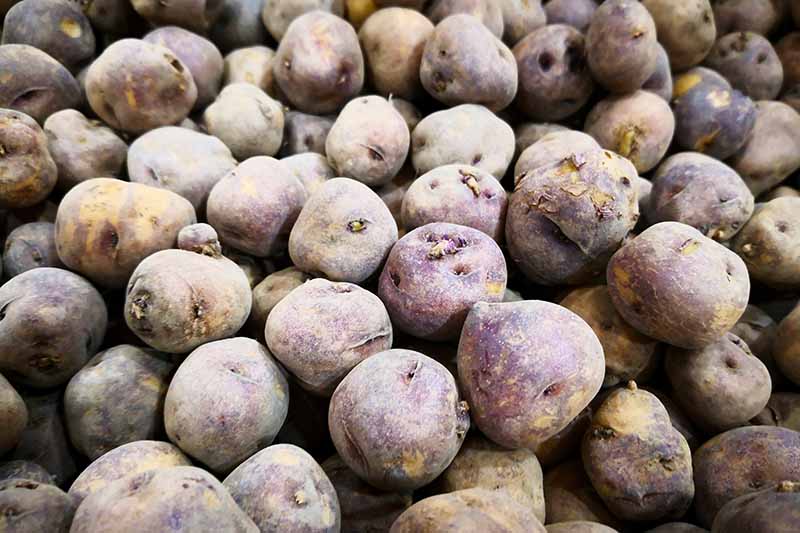
Canarian potatoes are varieties of S. tuberosum and S. chaucha that were brought to the Islands in 1622 by Europeans. Over time, they have been grown in the rich volcanic soil of the Canary Islands and have taken on a thin skin and a round shape.
Early papas negras have deep purple-black skin surrounding yellow-colored, sweet, buttery flesh. The semi-smooth skin is glossy when washed, but pale and matte when you first pull them out of the ground.
Use them to make the island’s famous papas arrugadas. The “wrinkly potato” dish is comprised of potatoes boiled in salt water and then dried until the skin wrinkles.
It’s usually served with a side of mojo rojo, which is a combination of tomatoes, garlic, and hot peppers. My mouth is watering just thinking about it.
7. Harvest Moon
Slice open the dark reddish-violet skin of ‘Harvest Moon,’ and you’ll be greeted by creamy, pale yellow flesh.
Combined with the round shape, it’s like capturing a full moon on your plate. The flesh turns brighter yellow on cooking and has a delicious nutty flavor.
This cultivar was developed by Joel Vanderschaaf at Tuberosum Technologies Inc. in Saskatchewan, Canada in 2011. A cross between ‘Piccolo’ and ‘Ph.Sfd,’ it was released to the market in 2020.
A mid-season type, it resists cracking and scab. The jury might be out on whether gardening by the moon phases can benefit plants, but there’s no doubt gardening with ‘Harvest Moon’ is smart.
Visit Burpee to pick up 10 tubers for your garden.
8. Huckleberry Gold
With deep golden flesh encased in huckleberry purple skin, this tuber is a feast for the eyes.
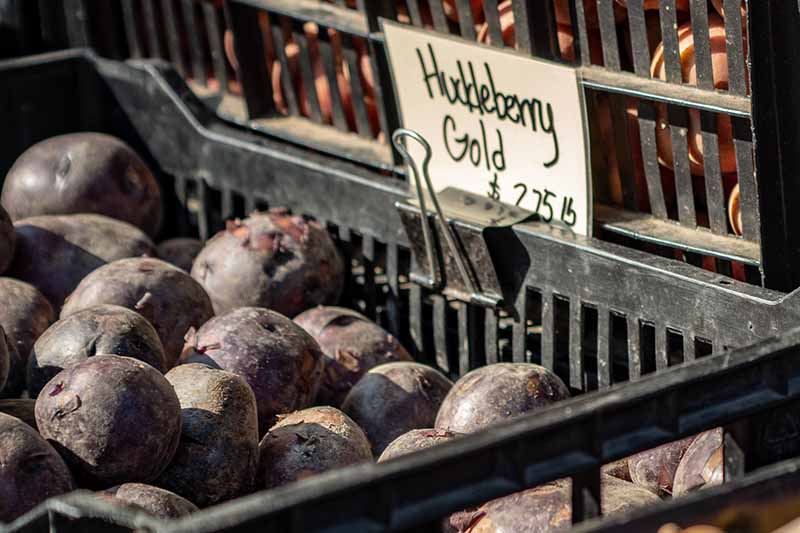
‘Huckleberry Gold’ was first bred in 2003 from Agria and ‘COA94019-5R’ in a field in Aberdeen, Idaho. It was further refined and then released to the market in 2011 by the Northwest (Tri-State) Potato Variety Development Program.
Montana State University plant pathology professor Dave Sands’ lab identified this beauty in 2016 as the first variety to be released on the market as approved for diabetics to eat because it is low on the glycemic index. It’s also higher in antioxidants than your average tater.
Go ahead and skip the butter because the flesh of this mid-season type is creamy and rich.
It’s also resistant to potato virus X and the golden potato cyst nematode.
Whether you’re looking for a healthier option or just a pretty one, pick up two-and-a-half-, 20-, or 40-pounds at High Mowing Seeds.
9. Magic Molly
No, these potatoes aren’t actually black – but you’re excused if you thought they were. The skin is such a dark purple that it looks that way.
Inside, the flesh is nearly as dark, with a strong purple hue that persists even after cooking. It has an earthy flavor with a waxy texture.
Bred near Palmer, Alaska, by potato disease control specialist Bill Cambell at the state-run Plant Materials Center, the tubers have an oblong, fingerling shape. He bred it out of ‘Red Beauty,’ and named it for his daughter in 2007.
The mid-season plants are extremely vigorous and will have you swimming in a magical sea of nearly black, fingerling tubers.
Pick up one, two and a half, 20, or 40 pounds of ‘Magic Molly’ at High Mowing Seeds.
10. Purple Majesty
Purple all the way through, ‘Purple Majesty’ has soft, buttery flesh and vibrant, thin skin that holds its color even after cooking.

To be totally accurate, the skin is purple with just a hint of wine red, while the interior is speckled with bluish-purple shades.
The flesh is sweet and buttery, perfect for mashing.
‘Purple Majesty’ was bred by Colorado State University San Luis Valley Research Center and is an early maturing type.
It’s moderately resistant to leafroll but susceptible to blackleg and pink rot.
Make 10 tubers yours by visiting Burpee.
11. Purple Rain
You’ll want to dance for joy in the purple rain when you see how striking these tubers are.
These potatoes look like vibrant jewels. The firm skin is so dark that it’s nearly black, but once you open them up, you’re treated to a rich eggplant interior speckled with white flecks.
The flesh is sweet and delicate and retains its color even after cooking.
Imagine a bowl full of the oval tubers of this early- to mid-season type. Stunning. They will be just as stunning as you dig into the sweet, delicate flesh.
12. Purple Viking
With skin dotted with dark eggplant and vibrant pink, ‘Purple Viking’ looks almost too good to eat.

Slice this mid-season type open, and you’ll be greeted by snow-white flesh with a buttery texture.
This oval, medium-sized, all-purpose type stores particularly well, but it probably won’t last that long since it’s going to be in constant demand at the dinner table.
If you live somewhere dry, ‘Purple Viking’ is tolerant of drought, within reason. The tubers tend to be uniform, with a similar shape and size.
Pick up two-and-a-half pounds at High Mowing Seeds.
13. Shetland Black
Hailing from the Shetland Islands, ‘Shetland Black’ has been around for over 100 years.
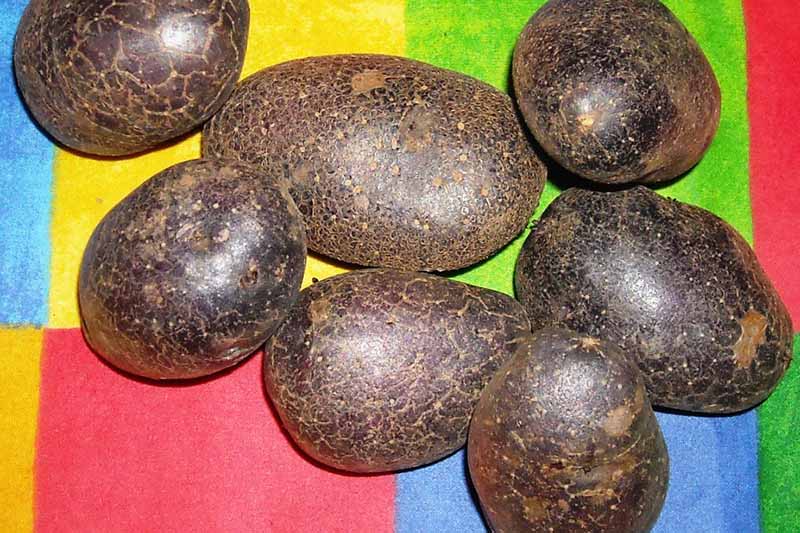
Looking as though they’ve been dipped in mulberry wine, the skin is mottled brown, mulberry, and true purple.
Inside, the petite ovals have a creamy white flesh with a ring of purple between the flesh and skin.
Although the tubers are tiny, each early-season plant produces an abundant harvest. The flavor is sweet and buttery.
Black and Blue Can Be a Good Thing
All potatoes are healthy, but purple and blue ones have a little bit of an edge, thanks to those groovy anthocyanins.
Honestly, I’d eat them even if they were slightly less healthy than the average tuber as they’re just so beautiful.
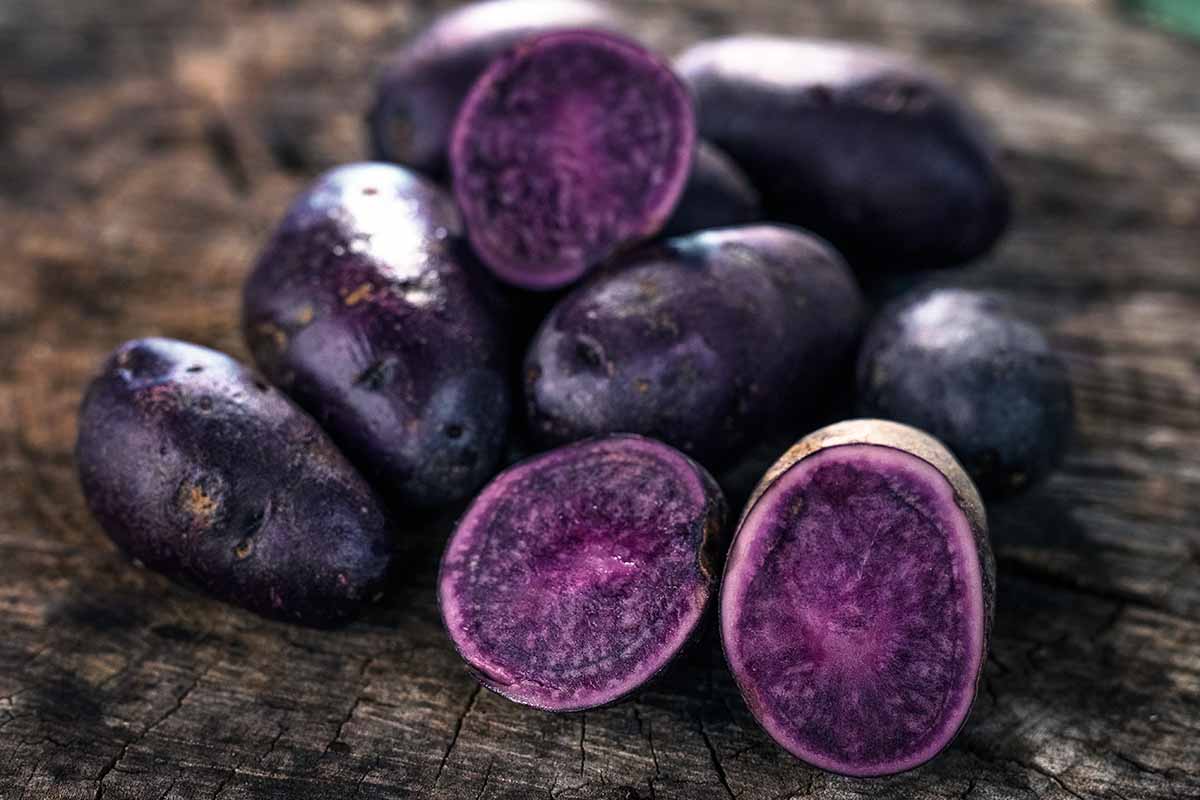
No longer a side dish, whether you mash, fry, roast, or turn them into chips, they’re going to be the centerpiece of your meal.
How do you plan to use up your tasty taters, and which one on this list is calling your name? Fill us in on all the details in the comments section below.
Now that you’re swimming in colorful tubers, you might have a hankering for more knowledge about potatoes. If so, we have a few more guides worth exploring:
